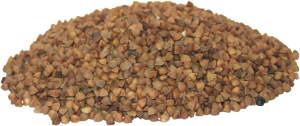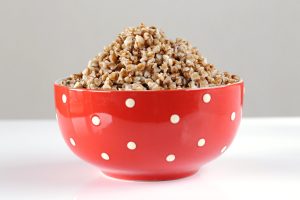
Buckwheat has been a popular food source for centuries, with a long and interesting history. It is a plant-based, gluten-free food, and one of the most nutritious and healthiest grains in the world. While it has only recently become popular in the Western world, it has been a staple in many cultures for centuries.
Buckwheat is a grain-like seed and is actually related to rhubarb and sorrel. It grows in dry climates and is most common in Eastern Europe and parts of Asia. It is high in protein, fiber, and a variety of other nutrients, making it a great choice for anyone looking to add more plant-based foods to their diet. Additionally, buckwheat has a nutty flavor and chewy texture, making it a versatile addition to many dishes.
Nutritional Benefits of Buckwheat
Buckwheat is a great source of dietary fiber. One cup of cooked buckwheat contains 8 grams of dietary fiber, which is approximately a third of the recommended daily intake for adults. Dietary fiber is essential for maintaining regular bowel movements and preventing constipation. It also helps to reduce cholesterol levels, which can reduce your risk of heart disease.
Buckwheat is also a good source of essential vitamins and minerals. It is rich in B vitamins, including thiamin, riboflavin, niacin, and folate. B vitamins are important for maintaining healthy skin and hair, and for energy production. Buckwheat also contains several minerals such as iron, magnesium, phosphorus, zinc, and manganese. Iron is important for forming red blood cells, magnesium plays a role in bone health and energy production, and zinc helps to maintain a healthy immune system.
Buckwheat is considered a low-glycemic index food, which means it can help to stabilize blood sugar levels. Eating a diet that is rich in low-glycemic index foods can help to reduce the risk of type 2 diabetes. Buckwheat also contains a type of antioxidant called rutin, which can help to lower blood pressure and reduce inflammation.
Buckwheat is a great source of plant-based protein. One cup of cooked buckwheat contains 6 grams of protein, which is nearly the same amount as a large egg. Protein is an important part of a healthy diet as it helps to build and repair muscle and other tissues in the body. Eating a diet that is rich in plant-based proteins can help to reduce the risk of heart disease and certain types of cancer.
History of Buckwheat
The origin of buckwheat is thought to be in Southeast Asia, where its wild ancestor Fagopyrum esculentum has been found in archaeological sites dating back to 8,000 BC. By the 5th century BC, buckwheat had been introduced to Europe and was being used as a food crop. It was a popular food among farmers in Europe during the Middle Ages, particularly in what is now France, Germany, and the Netherlands. In these countries, buckwheat was known as “sarachen”, “beech wheat”, or “sarrasin”, which are derived from the Latin language.
By the 16th century, buckwheat had made its way to the Americas, where it was cultivated by Native Americans. It became an important food for many of the tribes, especially in what is now the northeast United States. The Iroquois people were known to grind the grain into a flour that was used to make pancakes, which they called “sa-sa-ron-hoh”. This dish eventually became popular with settlers in the area, who called it “buckwheat pancakes” or just “buckwheat”.
The popularity of buckwheat continued to grow in the United States and Canada throughout the 19th century. It was an important crop in many areas, particularly in rural parts of the Midwest and Canada. In the early 1900s, it was also popular in Russia, where it was known as “grechka”. This was due to the fact that it was much more affordable than other grains that were commonly used to make bread, such as wheat and rye.
Today, buckwheat is enjoyed around the world, in various forms. In some parts of Asia, buckwheat noodles are a popular dish. In Japan, buckwheat is used to make soba noodles and in Korea, it is ground into a flour to make hotteok, a type of sweet pancake. In Europe, buckwheat flour is used to make crepes and pancakes. And in the United States, buckwheat is found in pancakes, waffles, and even breads.

Cooking with Buckwheat
Buckwheat is an incredibly versatile and nutritious food that can be used to create a wide variety of delicious dishes. From hearty breakfasts to savory dinners, buckwheat is a great option for those looking to increase their intake of whole grains.
The first benefit of cooking with buckwheat is its nutrient-density. Buckwheat is a whole grain, meaning that it’s packed with fiber, protein, vitamins and minerals. It’s especially high in magnesium, copper, and manganese, which can help regulate blood pressure and support bone health. It’s also a good source of antioxidants, which can help protect your body from free radical damage. Buckwheat is also low in calories, making it an ideal choice for those watching their weight.
When it comes to preparing buckwheat, there are a few different methods. The most common way is to boil it like rice. To do this, you’ll want to start by rinsing the buckwheat and then adding it to boiling water. You’ll want to cook the buckwheat for around 15 minutes, until it’s soft but still has a bit of a bite. Another way to prepare buckwheat is to toast it in a dry skillet over medium heat until it begins to turn golden brown. This will give your buckwheat a nutty flavor and help it retain its texture when cooked.
Now that you know the basics of cooking with buckwheat, let’s look at some tasty recipes. One of the most popular dishes is buckwheat porridge. To make this dish, you’ll start by combining cooked buckwheat, almond milk, cinnamon, and maple syrup in a pot. Simmer the mixture for around 8 minutes, until it thickens up. Serve the porridge with your favorite toppings, such as sliced bananas, chopped nuts, or fresh berries.
Another delicious way to enjoy buckwheat is in a savory breakfast bowl. Start by sautéing some mushrooms, onions, and garlic in a pan. When they’re cooked, add in cooked buckwheat, along with some spices such as smoked paprika and chili powder. Cook the mixture for another few minutes and then serve with a poached egg, some diced tomatoes, and a sprinkling of parsley.
For dinner, buckwheat makes an excellent base for a veggie-packed bowl. Start by cooking buckwheat according to the package instructions. While it’s cooking, prepare a mix of diced vegetables, such as bell peppers, zucchini, and carrots. Heat some oil in a pan and then add the vegetables, along with some spices such as cumin, turmeric, and garlic powder. Sauté the vegetables until they’re tender and then add them to the cooked buckwheat. Top the bowl with some feta cheese and a dollop of Greek yogurt for a delicious and nutritious meal.
As you can see, there are many ways to enjoy buckwheat. Not only is it a nutrient-dense whole grain, but it’s also incredibly versatile and can be used to create a wide variety of delicious dishes. Whether you’re looking to boost the nutrition of your breakfast, whip up a quick lunch, or prepare a hearty dinner, cooking with buckwheat can help. Try some of the recipes mentioned above, or experiment with your own combinations to create a meal that’s uniquely yours.
Clinical Trials on Buckwheat
The first clinical trials to examine the potential health benefits of buckwheat were conducted in the late 1980s and early 1990s. These studies examined the effects of buckwheat consumption on blood pressure, cholesterol, and glucose levels. The results of these studies were mixed, but some studies suggested that buckwheat consumption could lead to improved blood pressure and cholesterol levels.
Since then, more studies have been conducted to examine the potential health benefits of buckwheat. In 2008, a study published in The American Journal of Clinical Nutrition found that buckwheat consumption could reduce the risk of type 2 diabetes. The study followed over 2,000 people for nine years and found that those who ate buckwheat 2-3 times a week had a 20% lower risk of developing type 2 diabetes.
In addition to diabetes, buckwheat has been studied for its potential benefits in reducing the risk of heart disease. A 2020 review of clinical trials concluded that regular consumption of buckwheat could reduce total cholesterol and LDL (“bad”) cholesterol levels, as well as reduce inflammation and oxidative stress. This could potentially have a beneficial effect on heart health.
In recent years, buckwheat has also been studied for its potential benefits in reducing the risk of cancer. A 2018 study found that buckwheat consumption could reduce the risk of colorectal cancer. Specifically, the study found that those who ate buckwheat 2-4 times a week had a 27% lower risk of developing colorectal cancer, compared to those who did not consume buckwheat.
In addition to its potential benefits for diabetes, heart disease, and cancer, buckwheat has also been studied for its potential benefits in treating inflammatory bowel disease (IBD). A 2020 review of clinical trials concluded that the dietary fiber and antioxidants found in buckwheat could help reduce inflammation and improve gut health in people with IBD.